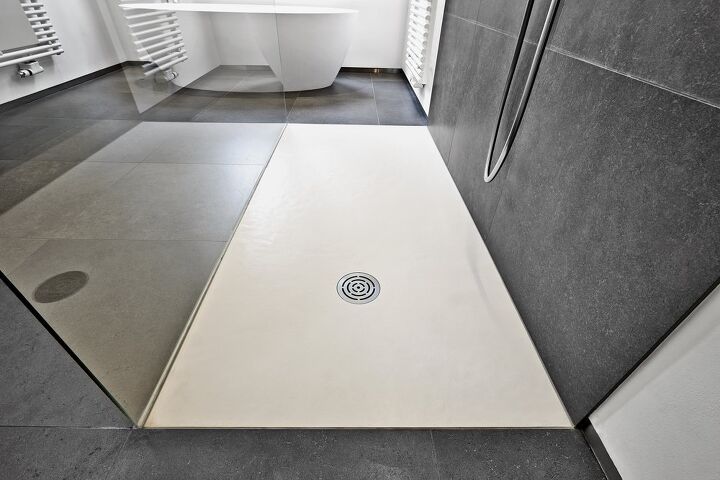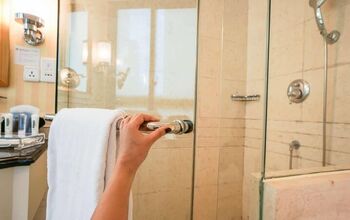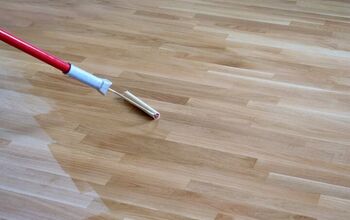8 Types of Shower Drains (with Photos)

When it comes to designing or renovating a bathroom shower, most homeowners place a strong emphasis on appearance rather than function. However, because you likely don’t want to shower while standing in dirty water, the drain is one of the most important components of your shower. There are many different types of shower drains, some of which are the only application for specific situations.
The two main types of shower drains are linear and point drains. One-piece, multipiece, and three-piece shower drains are all point drains that go in the center of a shower. Hidden and decorative shower drains are linear drains that go up against the shower wall. Point drains are the most common and inexpensive, but linear drains work best for curbless showers.
Ultimately, the type of shower drain you choose will depend on the slope of your bathroom floor, the type of shower, the flooring, and the style you’re going for. It is crucial that you choose your shower drain wisely. Otherwise, you risk a number of unnecessary consequences, including leaks that can result in mold in mildew forming underneath the floor of your shower.
Types Of Shower Drains
Shower drains are split into two main categories: linear and point drains. Beyond that, there are five types of shower drains to choose from. These include one-piece, hidden, multipiece, three-piece, decorative, and tileable drain grates.
Shower drains vary in style, size, price, and function. So, it’s best to familiarize yourself with each option to decide which is the best choice for your shower.
1. Linear Shower Drains
Linear shower drains are one of two main types of shower drains. They are notable for their long, rectangular shape. It is common to find linear drains in showers with tiles, ideal for curbless showers. The floor slopes towards the drain in a single direction so that water works its way down the drain.
Linear drains are pricier than their counterpart, point shower drains, but they are worth the cost. You can install any type or size of tile in your shower, and it should work with a linear drain. Linear drains are often backed up against the wall, perfect for walk-in showers.
However, one of the cons of linear shower drains is that it can be difficult to clean them. Luckily, you can install linear shower drains on your own without trouble, so it is the perfect option for DIY homeowners.
2. Point Drains Are The Most Common Types Of Shower Drains
The other main category of shower drains is a point drain. These drains are what the average homeowner pictures when they think of a shower drain.
You can find point shower drains directly in the middle of the shower floor. Point drains generally come in a round or square shape, and they are ideal for installing with small tiles.
One of the downsides of point drains is that you cannot always install a point drain with large tiles. Point drains are cheap, easy to install, and you can find them anywhere. They may seem small, but it is rare to have difficulty draining all of the water with a point drain.
Point drains are much easier to maintain than linear drains because you can clean them with ease. You can find decorative drain covers for point drains if you want to add character to your shower.
3. One-Piece
One-piece shower drains are simple, dependable, and easy to clean. You likely have a one-piece shower drain if your shower was built over a concrete slab. One-piece shower drains go directly over the drainpipe, and they are the easiest to install.
Their design may seem simple, but one-piece shower drains are effective enough to prevent clogs and leaks. One-piece shower drains are the most suitable for concrete bases because concrete can withstand water.
You can find one-piece shower drains for as little as $12. Installation costs are nonexistent because you can install a one-piece shower drain with no more than a screwdriver.
4. Three-Piece
Three-piece drains are highly effective and can prevent harmful leaks and expensive repairs. Homeowners with a wood floor beneath their shower can benefit the most from three-piece shower drains. You need a shower pan if you have a wood floor, and that is where three-piece drains come into play.
Three-piece shower drains are perfect for a shower pan and ultimately prevent water from seeping through. Showers built over wood are at the highest risk for mold and mildew, which can both cause health problems. They aren’t as easy to install as one-piece shower drains, and you’ll want to hire a professional to install a three-piece drain.
You can install it yourself if you put the bottom piece in the drainpipe and the middle piece over the shower pan. The top part simply screws in like on a one-piece shower drain.
5. Multipiece
Multipiece shower drains are the most advanced and complicated point drain. You need a multipiece shower drain if you have a simple one-piece shower stall. Each part of a multipiece shower drain attaches to the drainpipe except for the top.
The top of a multipiece shower drain screws in simply like a one-piece shower drain and takes 2-4 screws. There are tight rubber seals in multipiece shower drains that can withstand high water pressure. Multipiece shower drains are difficult to install, but they accommodate the most simple types of showers.
6. Decorative Types Of Shower Drains
Decorative shower drains exist purely for aesthetic purposes. They are generally no different than standard 1-3 piece shower drains, but they feature a decorative drain cover. Homeowners spend an average of $60 on decorative shower drain covers if there is already a drain in place.
Engraved decorative shower drains can cost over $100, and you can customize them to suit your bathroom. You generally don’t lose any function with a decorative shower drain, and their unique appearance simply adds a unique flair.
Decorative shower drains fall into the point drain category, and they are easy to install. You can easily remove a decorative shower drain to clean it.
7. Hidden Types Of Shower Drains
Hidden shower drains are a type of linear drain that blends in with the floor. You generally need to pick a hidden shower drain during construction or before you update your bathroom. Hidden shower drains are diverse and work well with both small and large tiles.
You can often find hidden shower drains in curbless showers, but they aren’t limited to them. There are point-drain style hidden shower drains that you can match to your tile.
8. Tileable Drain Grate
Tileable drain grates aren’t exactly a type of shower drain, but they can attach to most point drains. You can attach a tileable drain grate to a shower drain if you have a shower liner. They come in several styles, and you can generally find one to suit any aesthetic.
However, tileable drain grates affect how quickly the water works its way down your drain. That is only a problem when your shower drain or drainpipe is clogged, and that can make the problem worse. Tileable drain grates are a great way to prevent loose items from falling down your shower drain.
Make sure that your tileable drain grate is compatible with your one-piece or multipiece shower drain.
Point Drains vs. Linear Drains
With linear drains experiencing such a major growth in popularity, it’s worth comparing the difference between them and point drains to help you come to a decision. That said, let’s compare point drains vs. linear drains on the basis of design, maintenance, tile usage, and cost.
Design
When it comes to design, linear drains offer a more sophisticated look than conventional point drains. You can choose from two main types of linear drains: grated linear drains and tile finish linear drains. Grated linear drains are constructed of metals such as stainless steel and feature an array of colors and designs.
Whereas, tile finish linear drains are designed to imitate the tiling on the shower floor. With this option, the linear drain blends seamlessly into the bathroom as opposed to being an eyesore at the bottom of your shower.
Maintenance
Most linear drains are outfitted with a debris basket that collects hair and other materials. The basket is easily accessible and makes linear drains easier to maintain than point drains.
Tile Usage
Point drains are ideal for shower enclosures with smaller tiles – preferably no larger than 4 feet by 4 feet. Linear drains, on the other hand, can essentially be used for tiles of any size.
Point drains must also have a multi-directional gradient in the shower for it to drain successfully, while linear drains need a unidirectional gradient. The difference in gradient makes linear drains easier to install.
Cost
When you compare the two main types of shower drains in terms of cost, point drains are more affordable than linear drains. You can usually find point drains for as little as $50. Though, linear drains will cost you anywhere from $200 to over $1,000.
Types Of Shower Drains Based On Shower Floor
Before you choose a shower drain, it’s crucial that you consider the type of shower that you’re going to be installing. The drain that you select must be determined based on both the type of shower and the construction of the bathroom floor. Below we’ve outlined the three main types of shower point drains for specific circumstances: one-piece shower drains, three-piece shower drains, and multipiece shower drains.
1. One-Piece Shower Drain
As you might expect, one- or single-piece shower drains are the simplest type of drain installation for showers. You’ll typically find them paired with tiled shower bases over concrete bathroom floors. Since concrete floors are susceptible to damage caused by exposure to water or moisture, the simplest design is sufficient enough.
There are very few components involved in this design. One-piece shower drains consist of a strainer that is screwed into the recessed area of a pipe socket. The drain pipe is fitted into the socket, and the strainer is connected on top with screws.
2. Three-Piece Shower Drain
Three-piece drains can be used as a shower drain and also as a floor drain, as the construction is essentially the same. These drains are best suited for situations where an underlying shower pan or pan liner must fit a tiled floor. They serve to protect the wooden subfloor underneath from mold, mildew, and rot.
As the name indicates, three-piece shower drains consist of three components. The three parts of this drain allow you to adjust it according to the thickness of the tile installed on the shower floor. The topmost portion of a three-piece shower drain screws into the middle part of the drain, which is then screwed into the shower pan and pipe socket in the drain’s lower section.
These drains feature a top that is height-adjustable to match the tiles of your shower. Three-piece shower drains should only be installed by professionals. It’s very likely for the average DIYer to improperly seal all the components of the drain, leading to pricey damage to your subfloor caused by leaks.
3. Multipiece Shower Drain
Of the three types, multipiece shower drains are the most complicated. However, believe it or not, they are typically found in the most basic of shower stalls there are, such as one-piece shower stalls or those with premolded bases.
From the top to the base of the drain, multipiece shower drains feature a strainer, brass locking ring, rubber compression gasket, flange, threaded drain body, washer or rubber gasket, and a tightening nut. All of the parts from the strainer to the flange sit above the floor of the shower stall, and the rest are under the shower and must be installed first. Then, the shower or base can be put in place.
Types of Shower Drains: Style And Finish
Whether you choose to go with any of the aforementioned point drains or a linear drain, the last consideration that must be made is the style and finish of the grate. The grate is the portion of the drain that is visible at the base of your shower, and it’s important that it complements the style of your bathroom. In most cases, it’s ideal to choose a finish that matches the rest of the bathroom so that everything ties together.
In other words, if your shower head and taps are chrome, choose a shower drain that has a chrome grate to complete the look. Style, on the other hand, is a very personal choice. There are numerous options to choose from, whether you prefer something traditional or with a little bit more flair.
A very sleek, unique option for shower drain styles is to choose a tileable grate. With these grates, the same tile on the shower floor is applied to the top of the drain grate. The water drains around the edges of the tiled grate, becoming nearly invisible on the bottom of your shower.
Summing It Up
The two main kinds of shower drains and linear and point drains. Point drains go in the center of your shower floor, and linear shower drains run along your shower wall. It is easier to clean point drains, but linear shower drains are more modern and visually appealing.
One-piece shower drains are the easiest to install, and they are ideal if you have a concrete base. Three-piece shower drains are harder to install but are perfect if you have a wooden floor beneath the shower. Multipiece shower drains are for simple, one-piece shower stalls, and they are challenging to install.
Related Articles

Nick Durante is a professional writer with a primary focus on home improvement. When he is not writing about home improvement or taking on projects around the house, he likes to read and create art. He is always looking towards the newest trends in home improvement.
More by Nick Durante

































